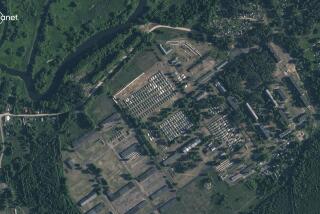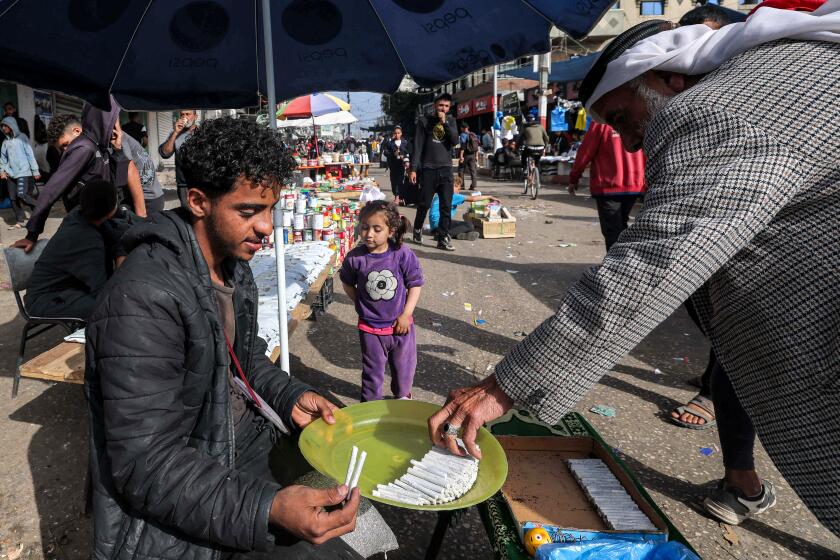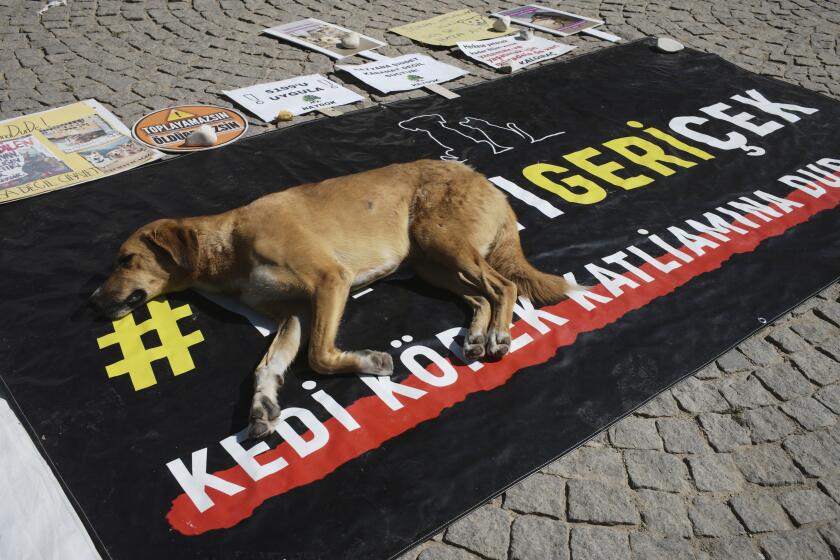Pope John Paul II Marks 25 Tumultuous Years
A quarter-century ago, when a relatively unknown Polish archbishop became pope, Jimmy Carter was president of the United States and the Soviet Union was a superpower. Leftist revolution swept into Latin America, championed in some cases by Roman Catholic priests. Israel and Egypt made peace. The world’s first test-tube baby was born.
The planet now is a very different place, and John Paul II, who today marks his 25th anniversary in power, has had a hand in shaping events to a degree unrivaled by any other religious figure in modern history.
His election on Oct. 16, 1978, “was itself a breaker of precedents,” the Jesuit magazine America said in an editorial this month, “and ever since his election, John Paul II’s pontificate has been setting records that none of his predecessors could have imagined.”
He is stooped, slumped and sick now, a shadow of the robust, athletic man who became the first non-Italian pope in 4 1/2 centuries. But he soldiers on, determined, his aides say, to work and preach until his life ends, serving in his waning years as a symbol of perseverance and faith over adversity.
On Wednesday, in his weekly audience at St. Peter’s Square, John Paul invited tens of thousands of pilgrims to join him today to “praise the Lord and thank him for this happy event.” He again had difficulty speaking but withstood an hour of ceremony.
Through the decades, John Paul has transformed the papacy and become a crusader who helped bring about the fall of communism, fostered a historic reconciliation between Catholics and Jews, and remained a steady -- if often ignored -- voice for peace and against war, including the wars waged by the West.
He also has imposed a conservative theological doctrine that brooks no dissent, and he has opposed in unwavering fashion the ordination of female priests, birth control, abortion and gay marriage.
Though a champion of the poor, he also has suppressed the leftist liberation theology that put priests in the trenches alongside the poor.
The force of his personality and moral authority have made him a hero in much of Europe and Latin America and some of the exotic places he has ventured to as part of a mission to make the church and the Holy See more visible.
Yet his orthodoxy and the sexual abuse scandal plaguing the U.S. church have contributed to the growing alienation from the Vatican of the American faithful, who account for a small but affluent percentage of the world’s 1 billion Roman Catholics.
“The pope is meant to be a bridge builder, and on the international front, he’s very much done that,” said the Rev. Keith Pecklers, a Jesuit professor of theology at Rome’s Pontifical Gregorian University. “But if you look back 25 years, the Catholic Church today is significantly more polarized and divided than when he was elected.”
When the final analysis of this pope’s legacy is written, then, it will be a story of contrasts, of ambitious goals, phenomenal successes and harsh disappointments -- of, in the words of one headline writer, revolution and rigidity.
Similarly, as he celebrates his anniversary, the joy of the moment is tinged with sadness.
The pope’s physical pain is clear to all; even cardinals speak openly of his mortality and no longer hide their alarm when the pope abruptly falls silent in the midst of a speech, unable to continue, as he did on a trip to Slovakia last month.
“I am increasingly aware that the day is drawing near when I will have to present myself to God to account to him for my entire life,” he told Polish pilgrims during celebrations marking his 83rd birthday in May. “I entrust myself to divine mercy and to the mother of God.”
John Paul has for years been afflicted with Parkinson’s disease, arthritis and other ailments; he was shot by a would-be assassin in 1981 and underwent surgeries to replace a hip and remove a tumor.
His infirmities have triggered a debate within the church over whether he should resign and, since it seems unlikely that he will, what would happen if he were to become incapacitated.
“From all I can see he is very much in control,” said Cardinal Roger Mahony, the archbishop of Los Angeles, who was in Rome on Wednesday for the anniversary. “Is he managing all aspects of the church like before? Of course not.”
The last pope to resign was Celestine V in 1294. Ever since, popes have died in office. But John Paul’s predecessors did not live with the same high profile that he does and easily could retreat into privacy without world alarm.
There are no provisions for substitution of a pope who falls into a coma or becomes so ill he can’t function.
Aides and doctors have urged John Paul to curtail his activities, and though he certainly does less now than he used to, he refuses to stop altogether. He will not hear of resignation, but he speaks of his death with growing candor.
“I think that now, after 25 years, he started closing a door behind him,” Marek Skwarnicki, a longtime friend, said in a telephone interview from Krakow, Poland.
“He is behaving like an old father, a good landlord who knows that soon it will be time for him to leave and he has to deal with all the remaining problems. He is thinking now in terms of months and weeks.”
Skwarnicki, a writer who has known John Paul for more than 40 years, penned the epilogue for “Roman Triptych,” the pontiff’s collection of poetry published early this year. The pope’s verses speak of death, and Skwarnicki sees them as a kind of last will and testament.
In addition, the pope recently moved up a meeting of cardinals by several months and appointed an additional 31 men to their elite ranks. The cardinals are charged with choosing a pope each time the Chair of Peter is vacated by death.
He also awarded promotions to several loyal and trusted aides in his inner circle, including his omnipresent secretary, Archbishop Stanislaw Dziwisz.
Joaquin Navarro-Vals, the Vatican’s chief spokesman, said John Paul had decided to use his frailty and suffering in his public mission, offering himself as a symbol of the ability, through determination, to overcome physical limitations.
“It is very moving how he has incorporated his physical limitations into how he performs his ministry,” Navarro-Vals said.
It will take years for scholars to assess and analyze thoroughly the legacy of John Paul II, who has written volumes of documents and encyclicals, traveled more than 725,000 miles, the equivalent of 29 times around the planet, and elevated more than 400 people to sainthood -- in effect broadening the definition of holiness.
The pope changed the world he lived in and he changed the church he led.
“It was [John Paul] who noticed what nobody else did: that people’s spiritual and moral strength could crush empires,” Skwarnicki said.
Not even a year into his reign, the pope returned to his homeland and in an enormous open-air Mass called on his countrymen to “Let the Holy Spirit change the face of the land, this land.”
A year later, the Solidarity movement was born and the beginning of the end of Soviet communism was launched.
John Paul redefined the papacy, returning it to its evangelical roots as embodied by Jesus.
Despite resistance from within the Catholic hierarchy, he has criticized past mistakes of the church and apologized -- for everything from forcing Galileo to recant to the roles played by Christians in the Holocaust, the Crusades and the conquest of the New World.
And he reached out to other faiths in unprecedented ways, becoming the first pope to visit a mosque and a Jewish synagogue.
On a trip to Jerusalem in 2000, he placed a message asking forgiveness in a crevice of the Western Wall, a site sacred to Jews.
In the realm of interfaith dialogue, however, the pope is also confronted with what he would consider one of the greatest disappointments of his papacy, a major chunk of unfinished business.
He has not been able to bridge the schism between Catholicism and the Eastern Orthodox Christian faith; in fact, relations have deteriorated between the Vatican and the Russian church, in part because of his encouragement of Catholic communities in the former Soviet Union. Moscow has refused to allow him to visit -- a glaring hole on his well-worn globetrotter’s map.
Another significant setback to his papacy has been the sexual abuse scandal in the United States and other parts of the world. Critics contend that the Catholic Church in the U.S. is adrift, alienated from the Vatican because of core philosophical differences and the pope’s insistence on lifestyle mores that seem unrealistic in America.
Therein lies another of the paradoxes of John Paul’s rule. He is mentioned annually as a Nobel Prize contender, yet his message is seemingly ignored in many places where he speaks. Arguably, the world is engulfed in more warfare now than at any other time during his reign, and church attendance is down while the Muslim and Protestant faiths make huge inroads in once-Catholic regions.
“Are we in the kind of world the Holy Father wishes? No,” Mahony said. “The human spirit is able to go in two directions and is free to make a choice, good or bad. That’s why [the pope] keeps calling on us to make the good choice. It’s been a constant struggle.”
*
Times staff writer Ela Kasprzycka in Warsaw contributed to this report.
*
(BEGIN TEXT OF INFOBOX)
Highlights of John Paul II’s papacy
1978 - (Oct. 16) Elected 264th pope, takes name John Paul II. He’s the first non-Italian pontiff since 1522.
1979 - (Jan.) Mediates a boundary dispute between Argentina and Chile.
1981 - (May 13) Mehmet Ali Agca shoots John Paul in St. Peter’s Square. Four days later, pontiff asks faithful to “pray for the brother who shot me.”
1982 - (May 29) John Paul prays at Canterbury Cathedral, the center of world Anglicanism - a move toward closing a rift that had opened during the reign of Henry VIII four centuries earlier.
1987 - (Sept.) Pope visits California, including first visit to Los Angeles.
1989 - More than 400 European theologians sign the Cologne Declaration, protesting the pope’s appointment of conservative bishops.
1992 - (Oct. 31) Acknowledges that Galileo was wrongly censured in 1633 by the Inquisition for demonstrating that Earth is not the center of the universe.
1994 - (June 15) Vatican establishes diplomatic relations with Israel.
(Sept. 5) Dispatches Vatican diplomats to a United Nations conference in Cairo to join Islamic states in opposing legal abortion and contraception for women in developing countries.
1995 - (Sept. 5) Mary Ann Glendon, the first woman to head a Holy See delegation, addresses a U.N. conference in China.
1998 - (Jan.) John Paul meets with Fidel Castro in Cuba, decries the “oppressive” U.S. trade embargo against the nation.
(March) Vatican, after a decade of preparation, issues statement of repentance for the “errors” of Roman Catholics who failed to help Jews during the Holocaust. But it also defends Pius XII, the pope at that time, who has been faulted for his silence.
2001 - (May) Apologizes to Orthodox Christians for the “disastrous” 1204 sacking of Constantinople - now Istanbul - which was the center of Eastern Orthodoxy.
2003 - (March) Speaks out against the U.S. plan to lead an invasion of Iraq, saying such a move would be “illegal and unjust.”
(Sept. 9) Church agrees to pay $85 million to settle civil suits brought on behalf of more than 550 alleged priest abuse victims and their parents in the U.S.
*
Sources: Vatican, staff research - Researched by Times graphics reporter Kristen Walbolt
More to Read
Sign up for Essential California
The most important California stories and recommendations in your inbox every morning.
You may occasionally receive promotional content from the Los Angeles Times.











